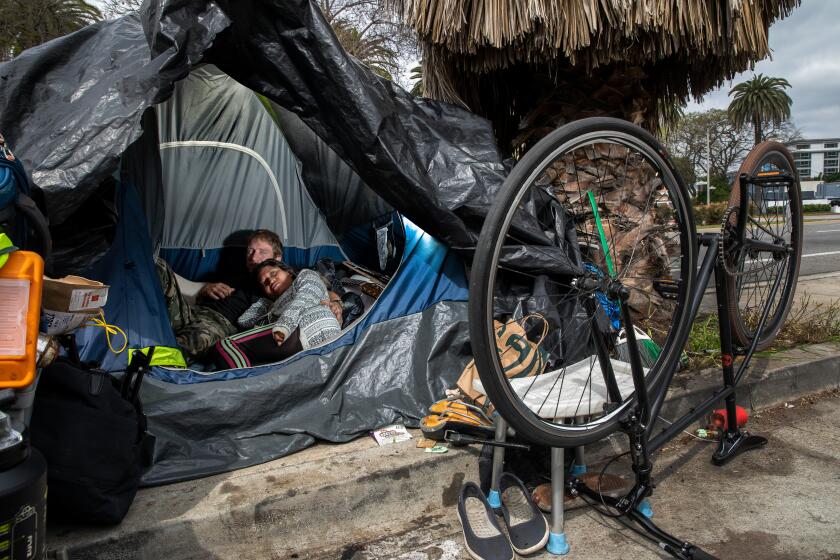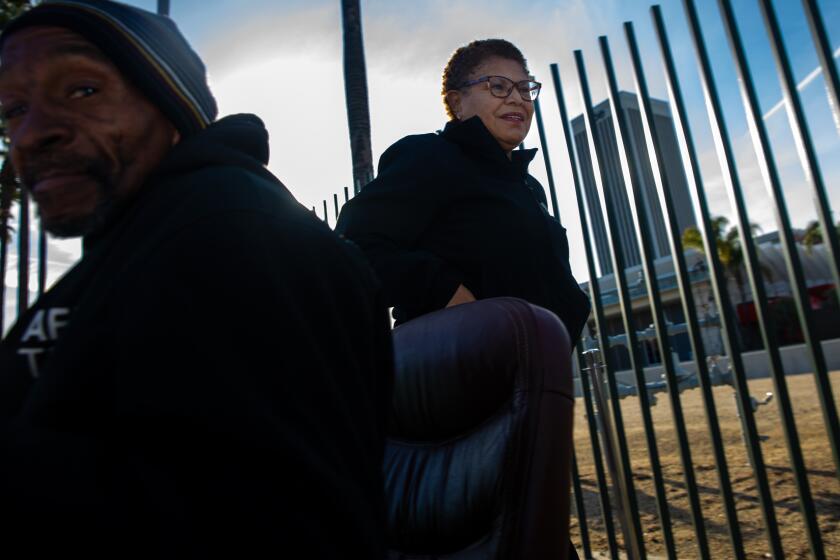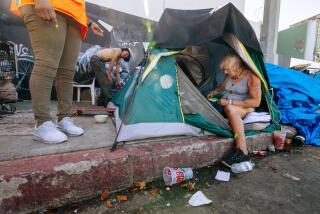Bass, one year in: Progress on homelessness but still a steep climb
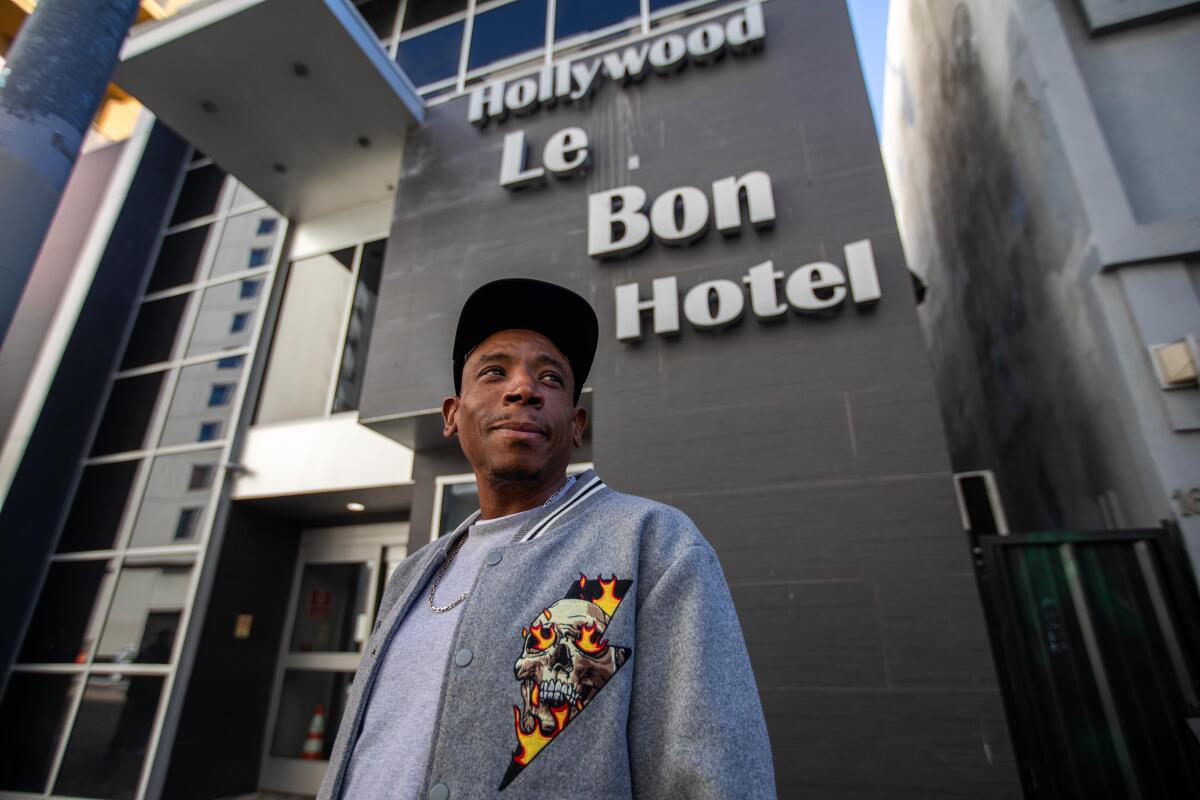
- Share via
Los Angeles Mayor Karen Bass had been in office for little more than week when she announced the launch of Inside Safe, her signature program to move homeless Angelenos out of the city’s biggest encampments and under a roof.
The first place she went was a noisy stretch of Cahuenga Boulevard under the 101 Freeway in Hollywood. Working closely with Councilmember Nithya Raman, city and county agencies found beds for about 30 unhoused residents living at or near the overpass.
Last week, the mayor celebrated her first year in office, touting the work her administration has done to address the crisis. By then, 10 more people had set up tents, tarps and at least one cardboard structure on the streets around the overpass that had been targeted by Inside Safe in December 2022.
The return of those encampments offers just one example of the challenges the mayor will face in the second year of her fight against homelessness.
Since taking office, Inside Safe has moved 1,951 people off sidewalks, median strips and alleys in such areas as Echo Park, North Hollywood, Westlake, Van Nuys and South Los Angeles, according to figures compiled by the Los Angeles Homeless Services Authority covering the period that ended Nov. 30.
At the same time, Bass has struggled to accomplish the crucial next step: moving those same people out of hotels and motels and into actual homes. Just 256 people, or 13% of the people who participated in Inside Safe, were in permanent housing during the time frame examined by LAHSA.
About 1,200 continue to live in hotels and motels, some of them for 10 months or more. An additional 100 or so are in tiny homes, shelters or other types of interim housing. The remainder have exited the program.
If Bass is unable to break the logjam, she will need to lease even more hotel rooms next year, even as her Inside Safe team heads into additional neighborhoods — while also returning to the areas where encampments have reemerged.
When she first took office, Bass expected that the encampment residents would end up staying in interim housing for three to six months. A year into the job, she says a more realistic duration, in at least some cases, will be one to two years.
Bass, in an interview, said the city already had thousands of other homeless residents waiting in line to get into permanent housing by the time Inside Safe was launched. “The question that remains to be answered is, where do the Inside Safe people fall in the line?” she said.
At least some of those other homeless hotel dwellers are losing patience.
Stephanie Ryan, who lived at one point under the Cahuenga overpass, said she has been trying to get into permanent housing for three years. Ryan, 33, has a room at the Highland Gardens, a hotel used by the city as interim homeless housing, although not for Inside Safe. After two separate stays in that facility, plus a stint in a hotel near downtown, Ryan said she has felt the temptation to return to the street.
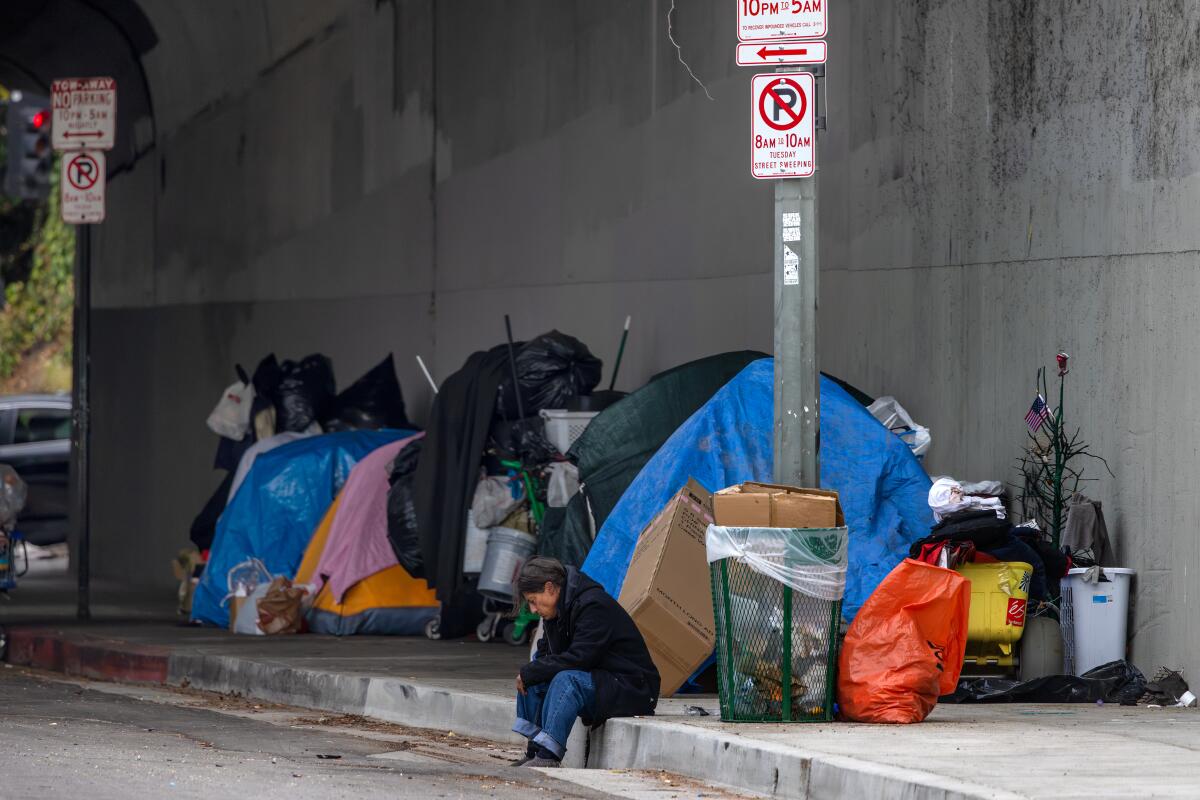
Ryan said she doesn’t like having her belongings searched when she enters the hotel or having to check in each night. She also dislikes random room inspections.
“I don’t like having to answer for everything I do,” she said. “It’s not like I’m in an apartment where you can come and go.”
By mid-November, the city had agreements to use rooms at 46 hotels, including the 13-story L.A. Grand in downtown Los Angeles and the Motel 6 in Canoga Park, according to a city analysis. Bass has made moves to build out the city’s own interim housing portfolio by purchasing and renovating the 294-room Mayfair Hotel, at a cost of $83 million.
Bass said she is determined to clear the bottleneck that is preventing unhoused residents from getting into homes by fast-tracking the approval of 9,000 units of affordable housing. She also has focused on removing bureaucratic barriers that have delayed the move into permanent housing.
In addition, the mayor promised to send city crews back to the Inside Safe locations where tents have reappeared.
“I guarantee you, by the end of the year, all of those areas will be cleared too,” she said at a briefing last week.
*
Inside Safe is only one part of Bass’ strategy for combating homelessness. During her first year, she has pushed for the construction of more affordable housing on publicly owned land, including properties owned by Metro. She has fostered a new culture of collaboration between city and county agencies, which historically have been at odds.
Still, no homeless initiative has become more closely linked with Bass than Inside Safe. The program, which received $250 million in this year’s city budget, sends outreach workers to encampments to make voluntary offers of housing — usually hotel and motel rooms.
At least 25 people were relocated from a homeless encampment on San Vicente Boulevard as part of L.A. Mayor Karen Bass’ Inside Safe program.
Bass declared early on that the removal of street encampments would be a key feature of the initiative. More than once, she has said that Angelenos will not believe the city is making serious headway on the homelessness crisis if they continue to see tents in their neighborhoods.
On that front, she has made serious progress.
The Times visited 31 of the 32 Inside Safe locations targeted by Bass by Nov. 30. About three-fourths were either entirely free of encampments or had only a handful of tents — three or fewer.
On Hoover Street in Historic Filipinotown, sidewalks underneath the 101 Freeway that were unusable for years are finally clear of debris. On Culver Boulevard in Del Rey, a median strip that was once home to dozens of people had a single tent last month. In Chatsworth, only a couple of tents could be seen in recent weeks near a flood control channel that runs alongside a Metrolink station.
(The Times did not attempt to assess Inside Safe’s work in Skid Row, the part of the city with the largest concentration of homeless residents, because outreach teams went to different sections of that neighborhood.)
One of the largest Inside Safe operations took place in Venice, where, during the peak of the rainy season, more than 100 people agreed to move indoors. That encampment stretched across four streets and had been a long-standing source of neighborhood anger.
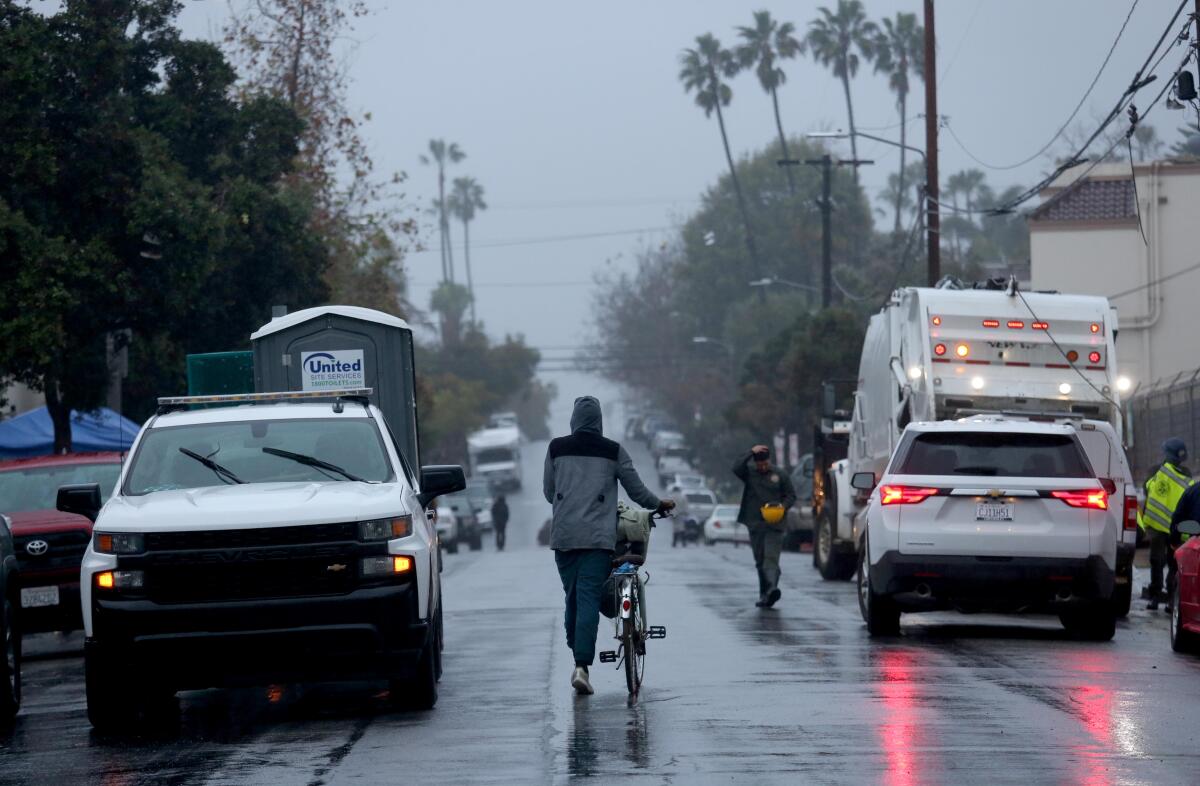
Since that operation, sidewalks in that area have been kept clean and safe, said Connie Brooks, a writer who has lived in the neighborhood for 25 years.
“It’s a very different environment,” she said.
Berta Jacobo, who resides in Westlake, said her neighborhood is also more peaceful in the wake of the mayor’s initiative. Outreach workers went to that densely packed neighborhood last month, focusing on several streets between Wilshire Boulevard and 8th Street.
Jacobo, 47, said she and her neighbors contacted the city more than a year ago, well before Bass won her race for mayor, about the heaps of trash and open drug use that they saw at the encampments. In those locations, fires had broken out, destroying at least two cars, she said.
“Things are so much better now,” Jacobo said.
Eight Inside Safe locations visited by The Times — about one-fourth of the total — have at least partially repopulated or were never fully cleared.
In April, the mayor’s team spent several days on the streets that surround El Pueblo de Los Angeles Historical Monument in downtown Los Angeles, moving nearly 80 people indoors. On Thursday, those streets had 36 tents or tent-like structures.
Inside Safe also went to a long-standing encampment in Harbor City, helping almost 70 people find interim housing. Last week, that area had a dozen tents.
In South Los Angeles, retired schoolteacher June Richard was thrilled to see Inside Safe visit her neighborhood last spring. On that day, city crews temporarily closed off 49th Street over the 110 Freeway. Outreach workers set up tables and chairs to make arrangements for the area’s unhoused residents.
The atmosphere was festive. By the end of the operation, dozens of people had been moved indoors.
Last week, Richard was no longer enthusiastic. The overpass near her home had four tents on the north side and three on the south. With trash scattered across sidewalks, the neighborhood “looks like a dump,” she said.
“I’ve seen people, a whole family, walking in the middle of the street because they have so much stuff on the overpass,” she said.
At some Inside Safe locations, new barriers make it difficult for homeless residents to return.
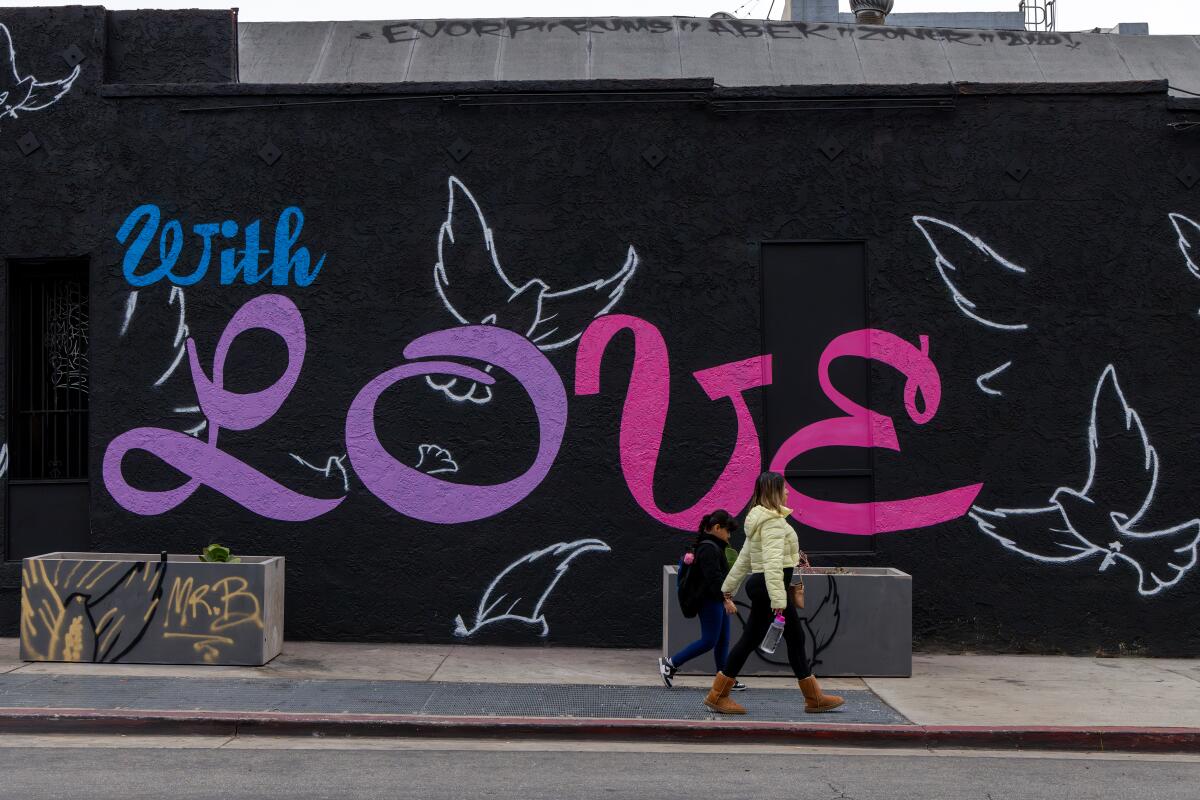
In Beverly Grove, city crews have fenced off several median strips on San Vicente Boulevard, adorning them with planters filled with multicolored succulents. In Mar Vista, new fences block the vast majority of the sidewalk on Venice Boulevard under the 405 Freeway.
In Hollywood, the mayor’s team targeted an encampment on El Centro Avenue that had experienced multiple fires, at least one involving a propane tank. Once the tents were gone, planters were added to the street. Months later, bigger ones were put in.
Mayor Bass said some who left Inside Safe have chafed at the rules imposed inside the program’s hotels, while others struggled with addiction or mental health.
Larry Slade, who heads the homelessness committee of the Sherman Oaks Homeowners Assn., gave the mayor’s work on homelessness a grade ranging from a B-plus to an A-minus, saying she has brought focus and funding to the issue. Still, he worries the crisis may be too big for any mayor to solve.
“Inside Safe is like trying to bail water out of a stream,” he said. “That program is an excellent idea, and she is the right person to lead that effort. I am just concerned that we are really just trying to mitigate a tidal wave.”
*
Of the 1,951 people relocated by Inside Safe through Nov. 30, nearly 400 people have exited the program, with the vast majority returning to homelessness, according to LAHSA’s most recent figures. Fifteen have died.
Bass and her team say that departure rate — nearly 1 in 5 participants — is much lower than that found in the other interim housing programs that serve homeless Angelenos.
Still, the mayor’s initiative has come under sharp scrutiny from the city’s mutual aid groups, which provide food, water, tents and supplies to the city’s homeless population. Some have criticized Bass for sending encampment residents to motels that are far from the neighborhoods where they were living. Others say the hotels lack sufficient social services.
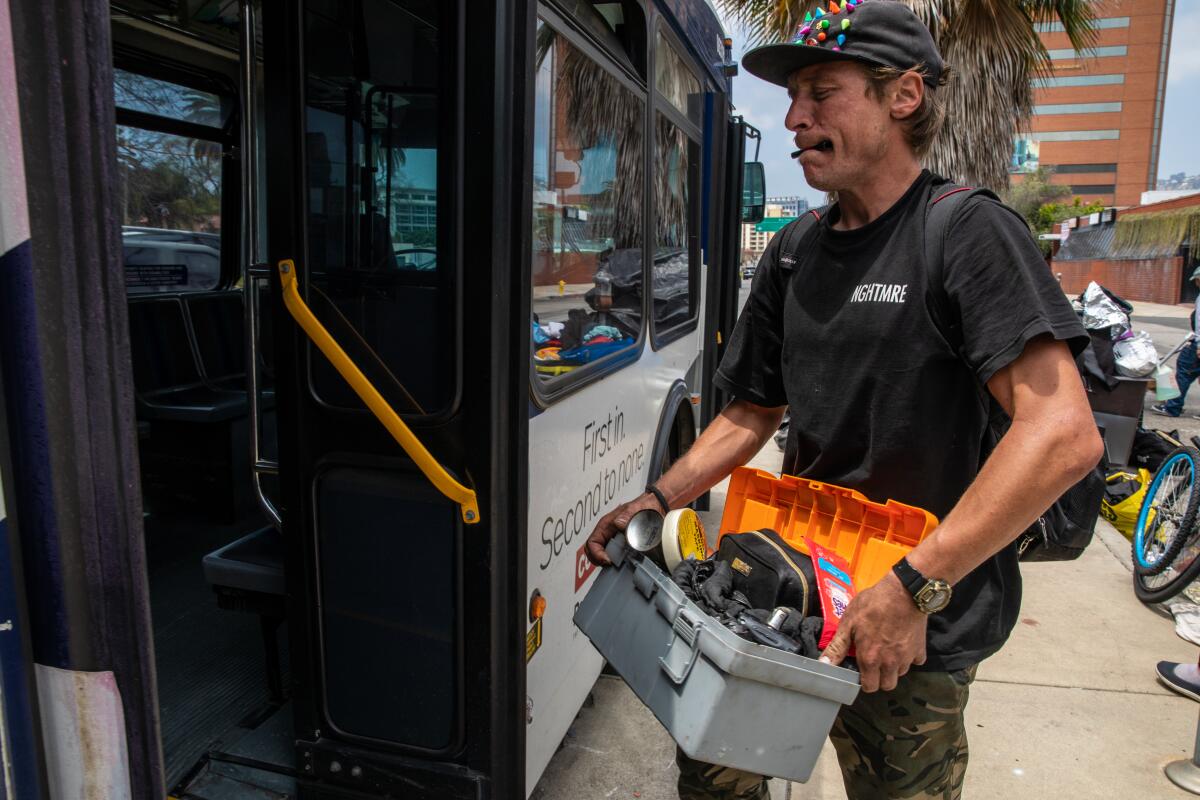
Carla Orendorff, a homeless advocate who lives in Reseda, said Inside Safe participants frequently feel pressure to give up their belongings, signing release forms or offering their consent on video. Unhoused residents have moved into motels, only to learn they are not permitted to have guests in their rooms, making them feel isolated and alone, she said.
One unhoused resident, who moved out of an encampment in Van Nuys, was later found dead of an overdose at his motel, Orendorff said.
“This policy is honestly killing people,” she said.
Asked about those assertions, Bass said the city needs to ensure that Inside Safe has a much better system of social services, including drug addiction treatment. She described that as a “top, top issue” for the coming year.
At the same time, the mayor argued that unhoused residents are much safer in hotels and motels than they are living on the sidewalk, where they are in danger of being raped, injured or killed.
“It is a travesty to leave people on the street,” Bass said.
Clairissa Jones, 24, is aware of the dangers. While living in Skid Row, she said, one assailant struck her with a pipe. Others stole her clothing and cellphones.
“One time I came back and my entire tent was gone,” she said.
Last month, outreach workers with Inside Safe found Jones a room at a hotel near MacArthur Park. Since then, she and her boyfriend have been enjoying the bed and the TV, while also relying on the medical clinic van that comes to the facility.
When Jones thought she had COVID-19, the hotel ordered her an Uber to take her to the hospital.
“I found out at the hospital that I was pregnant,” she said. “I got housing just in time.”
Clifton Grant Jr., 47, a former lab technician, had been living on Selma Avenue in Hollywood when the Inside Safe teams arrived. On that street, homeless encampments stretched on and off for nearly four blocks, occupying sidewalks on both sides of a grade school.
Get the lowdown on L.A. politics
Sign up for our L.A. City Hall newsletter to get weekly insights, scoops and analysis.
You may occasionally receive promotional content from the Los Angeles Times.
Grant, who grew up in Inglewood, became homeless about five years ago, during a serious mental health crisis. In August, Inside Safe teams moved him into a room in the Hollywood Le Bon Hotel that offered a bathtub, mini-fridge, microwave and queen-size bed. “I was blown away,” he said.
Since entering Inside Safe, Grant has had regular access to his medications and mental health treatment. He has been attending church and is talking about going back to school. He is extraordinarily grateful to the woman he calls “Miss Bass.”
“I’ve got something to wake up for now, with not just misery being upon me,” he said. “I get up, I thank God. I feel like I’ve got a purpose, like I can set goals now that seem achievable.”

Bass returned to Selma Avenue on Wednesday to celebrate the accomplishments of the last year. But in that neighborhood, it was clear that her initiative has a long road ahead.
One block south of Selma, more than a dozen tents lined the south side of Sunset Boulevard. At Hollywood Boulevard and Gower Street — a block east of the Inside Safe location on El Centro Avenue — nearly two dozen tents now cover the sidewalks.
Mayor Karen Bass’ Inside Safe initiative targeted an encampment that served as home to an estimated 98 people. By Monday, 82 had moved indoors.
On Cahuenga Boulevard, site of the mayor’s first Inside Safe operation, three people said they had already lived at one or more of the city’s homeless hotels. One said he was recently kicked out for yelling. Another said he got in trouble for having too many recyclables.
Asked about those locations, Bass said that as long as the city continues to have more than 46,000 homeless residents, the Inside Safe operations in Hollywood will be “a drop in the bucket.” Still, she said she remains optimistic — and intends to keep working to bring people off the street.
“We’re going to continue to knock down those barriers,” she said.
More to Read
Sign up for Essential California
The most important California stories and recommendations in your inbox every morning.
You may occasionally receive promotional content from the Los Angeles Times.
